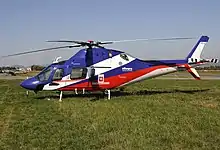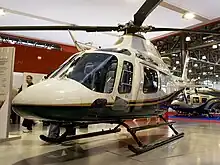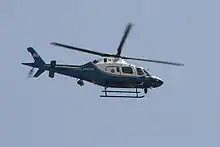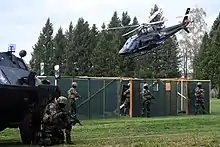AgustaWestland AW119 Koala
The AgustaWestland AW119 Koala, produced by Leonardo since 2016, is an eight-seat utility helicopter powered by a single turboshaft engine produced for the civil market. Introduced as the Agusta A119 Koala prior to the Agusta-Westland merger, it is targeted at operators favoring lower running costs of a single-engine aircraft over the redundancy of a twin.[2]
| AW119 Koala | |
|---|---|
.jpg.webp) | |
| An AW119 with the New York City Police Department | |
| Role | Utility helicopter |
| Manufacturer | Leonardo, previously Finmeccanica, AgustaWestland, Agusta |
| First flight | February 1995 |
| Introduction | 2000 |
| Status | In production |
| Primary users | State of Mexico Government Finnish Border Guard Portuguese Air Force United States Navy |
| Produced | 2000–present |
| Number built | ~300 (2018)[1] |
| Developed from | AgustaWestland AW109 |
Development
The A119 designation was first applied to a proposed 11-seat stretched version of the AW109 in the 1970s;[3] however this concept did not emerge and no such rotorcraft actually built. The helicopter that was eventually to enter production as the A119 was conceived in 1994, as Agusta was recovering from a period of financial woes that had nearly put the company out of business.[4] In February 1995, the second of two prototypes conducted its first flight.[5] The first prototype was used for static tests.[6] Civil certification was originally anticipated in 1997, this deadline was missed allegedly due to multiple issues such as personnel problems, the need to concentrate resources on the development of the A109 Power, and further development to increase the aircraft's performance to meet customer expectations.[7][5]
By way of a solution to the latter concern, the decision was taken to change the A119's powerplant. The prototypes were originally fitted with Turboméca Arriel 2K1 turboshafts, however the Pratt & Whitney Canada PT6B was chosen in its place.[8] In 1998, the prototypes were remanufactured with this engine, and assigned new serial numbers.[6] Certification was now expected by the fourth quarter of that year, but this date slipped to July 1999, and it was eventually December before Italian RAI certification was awarded.[5] US FAA certification was awarded in February the following year.[5] Customer deliveries began soon thereafter,[5] the first commercial example was delivered to Australian logistics company Linfox (serial 14007, registration VH-FOX).[6]
In April 2007, the AW119Ke (Ke standing for Koala Enhanced) was formally unveiled at Heli-Expo; changes included modified rotor blade design and a higher rotor rpm, increasing both payload and hot-and-high performance, cabin flexibility was also improved.[9] The fuselages of the AW119 are manufactured by PZL Swidnik of Poland, later a subsidiary of AgustaWestland.[10] Final assembly and other manufacturing activity initially took place at Vergiate, Italy; by the time the improved AW119Ke variant began production, the final assembly line had been transferred from Vergiate to AgustaWestland's facility in Philadelphia, United States.[11][12]
During January 2010, a partnership agreement was signed between Indian conglomerate Tata Sons and AgustaWestland as the foundations for a new joint venture, Indian Rotorcraft.[13][14] At the time, India was viewed by helicopter manufacturers as one of the biggest potential growth markets.[15] During March 2012, Indian Rotorcraft broke ground on a 40,000m2 new facility adjacent to Rajiv Gandhi International Airport, Hyderabad, India; The first helicopters to be manufactured by the joint venture is slated to be the AgustaWestland AW119Ke; other types, such as the AgustaWestland AW101, are likely to follow in the future.[16][15][17] During summer 2015, it was reported that further delays to starting assembly in India were likely as the Foreign Investment Promotion Board (FIPB), an Indian government agency, repeatedly deferred a pending decision.[18] During May 2016, another pending ruling by the FIPB was deferred without any stated reason; allegedly, the FIPB is liaising with the Indian Ministry of Defence on the matter.[19][20] The Indian government's apparent hesitancy on the issue has been alleged to be linked to the 2013 Indian helicopter bribery scandal.[21]
Design

The AW119 is a single-engine multirole helicopter. AgustaWestland promote the type as possessing excellent flight qualities with high levels of controllability, maneuverability and inherent safety.[22] The design of the rotorcraft is derived from Agusta's earlier and highly successful A109 helicopter, differing primarily by being equipped with a single engine (as the A109 was originally designed),[4] a Pratt & Whitney PT6B-37A turboshaft engine, and using fixed skids in place of the A109's retractable wheeled landing gear arrangement.[23] The AW119 shares the same cockpit and cabin of the AW109, along with commonality with various other systems, while costing roughly half of the latter's price tag.[7] According to Flight International, the AW119 is competitively priced and provides good levels of accessibility, maintainability, comfort, noise levels, and speed.[24]
The AW119 employs a four-bladed fully articulated main rotor; the composite rotor blades are designed to produce maximum lift with minimum noise, and feature tip caps to reduce noise and elastomeric bearings with no lubrication requirements. Aluminium honeycomb structural panels are used throughout the airframe, which absorb both noise and vibration, thus requiring no additional vibration absorption systems to be employed.[25] The PT6B-37A powerplant of the AW119, located in the same area as the AW109's engines, is capable of providing high power margins along with generous speeds and endurance.[22][26] According to AgustaWestland, the AW119 retains the system redundancy of dual engine helicopters, such as the hydraulics and the dual independent stability augmentation systems. The gearbox has a 30-minute dry run capability.[23][26]
The AW119 Koala has been used for various roles, including utility, emergency medical services (EMS), offshore, law enforcement, and executive transport.[23] A key selling point of the type is its wide-body fuselage, which allows for up to seven passengers to be seated in a three-abreast configuration in the cabin; for the EMS mission, up to two stretchers along with medical attendants and full emergency medical equipment suite can be accommodated, whereas most similar-sized helicopters can only carry one.[2] The unobstructed cabin area and separate baggage compartment can be rapidly reconfigured to suit a range of different missions and roles. Several different cabin interiors may be adopted to accommodate different missions and operations, such as executive/VIP, EMS, and utility options; the cockpit can also be isolated from the cabin.[22] The AW119 has been promoted as possessing the largest cabin in its class; the reported cabin volume is approximately 30% greater than other rotorcraft in its class.[8][22]
_at_the_Wagga_Wagga_Airport_heli-pad_(3).jpg.webp)
A wide range of avionics have been integrated upon the AW119, which are typically housed within the rotorcraft's nose.[27] Initial production models featured conventional flight instruments;[27] the Garmin G1000 glass cockpit is integrated on the newer AW119Kx variant, which is claimed to improve situational awareness, reduce pilot workload, and increase safety. Primary flight and other key information is displayed to the pilots upon two large 10.4 inch multi-function displays in the cockpit; an independently powered stand-by display is also present in case of system failure. Other avionics used include a 3-axis aircraft flight control system (AFCS), Synthetic Vision System (SVS), Highway In The Sky (HITS) depiction, moving map display, radio altimeter, VOR/ILS/GPS/WAAS navigation, Aural Warning Generator, and embedded Helicopter Terrain Avoidance Warning System (HTAWS).[22]
A variety of equipment can be equipped, dependent on operator choice and role; these include an external hoist, dual cargo hook, dual flight controls, baggage compartment extension, snow skis, windshield wipers, rotor brake, multi-band radios, active noise reduction headsets, soundproofing, oxygen systems, loud speakers, search lights, retractable landing light, emergency floatation equipment, reinforced windshield, wire strike protection system, rappelling kit, fire fighting belly tank, and a forward looking infrared (FLIR) camera.[22] Three fuel tanks, located behind the rear seats in the cabin, are installed as standard; up to two additional optional tanks can be fitted for a total of five, providing a flight endurance of nearly six hours.[7]
Operational history

Since 2009, there have been reports that final assembly of the AW119 is to be transferred to India as a part of a measure to increase sales within that market.[28][29] In February 2010, it was announced that AgustaWestland and Tata Group were to form a joint venture to produce the AW119 in India; the first Indian-manufactured units were originally planned to commence deliveries in 2011.[30] In October 2015, following two years of deliberation, India's Foreign Investment Promotion Board approved a proposal to locally assemble the AW119Kx in Hyderabad, Telangana; the facility is to be operated by Indian Rotorcraft Ltd (IRL), the joint venture between AgustaWestland and Tata.[31][32]
In September 2014, AgustaWestland issued a legal challenge to a United States Army decision to procure the Eurocopter UH-72 Lakota as a trainer without a competition, stating that both the AW119 and the AW109 had lower acquisition and operating costs; the challenge was dismissed in December 2014.[33][34]
In early 2015, AgustaWestland and Bristow Helicopters jointly offered an upgraded variant of the AW119 as a replacement for US Navy's existing fleet of 117 Bell TH-57 (based on the Bell 206) trainer helicopters under a fee-for-service contract; the companies claimed that over a four-year period the AW119 fleet could be introduced at an equal or lesser cost than that of continuing to operate the aging TH-57s.[35][36] Marketed by Leonardo as TH-119, it features a Genesys Aerosystems glass cockpit. It first flew on 20 December 2018.[38]
The TH-119 was selected as the successor of the TH-57 in January 2020, receiving the US military designation TH-73A. The US Navy expects up to 130 units to be acquired, with 32 ordered in January and an additional 36 in November 2020.[39] In August 2021, the TH-73 was named "Thrasher" for the brown thrasher, a bird common in the southeast US; the first example of the type was delivered on August 6.[40]
Variants
- A119 - designation for the original production version; maximum take-off weight: 2,720 kg (5,997 lb).[41]
- AW119 - designation for the A119 following the merger of Agusta and Westland Helicopters.
- AW119 MkII - improved version, featuring redesigned rotors, greater payload, and better fuel efficiency; maximum take-off weight: 2,850 kg (6,283 lb).[42]
- AW119 Ke - marketing designation for the AW119 MkII (Koala Enhanced).[41]
- AW119 Kx - successor to the Ke model with Garmin G1000H avionic suite, produced in Philadelphia, USA and Hyderabad, India.[32][43]
- TH-73A Thrasher - military training variant for the US Navy[39]
Operators
.jpg.webp)


%252C_on_6_August_2021_(210906-N-OU681-1162).JPG.webp)

- Bangladesh Air Force - 2 in service as of 2019.[47]
- Helicopter Service of Republika Srpska[48]
- Federal Highway Police (6 on order)[49]
- State of Goiás[50]
- State of Santa Catarina[51]
- State of Rio Grande do Sul[52][53]
- Ecuadorian Air Force - 3 delivered, 1 more on order as of April 2019.[54][55]
- Finnish Border Guard - 4 in operation.[56]
- Israeli Air Force (12 on order)[57][58]
- State Border Guard (2 on order)[60]
- Portuguese Air Force - 5 delivered (more 2 on order)[63][64]
- Air Mercy Services[65]
- New York City Police Department[66] (Replaced by Bell 429)
- Phoenix Police Department[67]
- United States Navy - 68 on order; up to 130 planned
- University of New Mexico Hospital Lifeguard air ambulance [68]
Specifications (AW119Kx)
| External video | |
|---|---|
Data from AgustaWestland AW119Kx brochure[23]
General characteristics
- Crew: 1-2
- Capacity: 6-7 passengers or 1,400 kg (3,086 lb) sling load
- Length: 12.92 m (42 ft 5 in)
- Height: 3.60 m (11 ft 10 in)
- Empty weight: 1,483 kg (3,269 lb)
- Max takeoff weight: 2,850 kg (6,283 lb)
- Fuel capacity:
3-cell fuel system 605 L (160 US gal)
4-cell fuel system 711 L (188 US gal)
5-cell fuel system 870 L (230 US gal) - Powerplant: 1 × Pratt & Whitney Canada PT6B-37A turboshaft engine, 747 kW (1,002 hp)
- Main rotor diameter: 10.83 m (35 ft 6 in)
- Main rotor area: 92.1 m2 (991 sq ft)
Performance
- Cruise speed: 244 km/h (152 mph, 132 kn)
- Never exceed speed: 282 km/h (175 mph, 152 kn)
- Range: 954 km (593 mi, 515 nmi)
- Endurance: 5 h 20 min
- Service ceiling: 4,572 m (15,000 ft)
- Rate of climb: 9.1 m/s (1,790 ft/min)
See also
Related development
Aircraft of comparable role, configuration, and era
Related lists
References
Citations
- "Latvia orders additional helicopters for State Border Guard". www.leonardocompany.com. Leonardo. 2 January 2018. Retrieved 6 August 2018.
- "The Agusta A-119 Koala". airliners.net. Retrieved 20 May 2007.
- Taylor, Michael J. H. (1989). Jane's Encyclopedia of Aviation. London: Studio Editions. p. 41.
- Simpson, R. W. (1998). Airlife's Helicopters and Rotorcraft. Ramsbury: Airlife Publishing. p. 33.
- "Flug Revue". Archived from the original on 15 June 2007. Retrieved 20 May 2007.
- Gualdoni, Damiano. "Damiano Gualdoni Aviation Enthusiast's Website". Archived from the original on 4 April 2007. Retrieved 20 May 2007.
- Gray 2000, p. 40.
- World Aircraft Information Files. London: Bright Star Publishing. pp. File 889 Sheet 32.
- "Rotorcraft Report: AgustaWestland Unveils Enhanced Version of AW119." Rotor&Wing, 1 April 2007.
- "Business: Good Week - Bad Week." Flight International, 16 March 2009.
- O'Keeffe, Niall. "AgustaWestland looks beyond national boundaries." Flight International, 31 October 2008.
- "Aviation News, Volume 69." HPC Pub, 2007. p. 24.
- Govindasamy, Siva (1 March 2010). "Indian aerospace industry opens up". Flight International.
- "Business briefs". Flight International. 30 November 2010.
- Govindasamy, Siva (21 March 2012). "Indian Rotorcraft breaks ground on Hyderabad facility". Flight International.
- V. Rishi Kumar. (15 March 2012). "Indian Rotorcraft breaks ground for Hyderabad copter facility". The Hindu. Retrieved 15 March 2012.
- Rao, Radhakrishna (11 November 2013). "India JV may open way back for AgustaWestland". Flight International.
- "Assembling of AW choppers by IRL likely to be delayed". Business Line. 22 July 2015.
- "Govt defers approval to AgustaWestland FDI in Indian joint venture". Hindustan Times. 3 May 2016.
- "'FIPB has sought Defence Min inputs on FDI in Agusta, Tata JV'". Deccan Herald. 3 May 2016.
- "Amid row over VVIP choppers scam, govt defers approval to AgustaWestland's FDI in Indian JV". indiatvnews.com. 2 May 2016.
- "AW119Kx: Fast and Flexible." Finmeccanica, Retrieved: 13 February 2016.
- "AW119Kx." Archived 16 February 2016 at the Wayback Machine Finmeccanica, Retrieved: 13 February 2016.
- Gray 2000, p. 43.
- Gray 2000, pp. 40-41.
- Gray 2000, p. 41.
- Gray 2000, p. 42.
- Aviation Week & Space Technology, Volume 170, Issues 1-10. 2009. p. 95.
- "AgustaWestland firm on expanding footprint in India." The Hindu, 24 September 2013.
- Pustam, Anil R. "Rotor market strong on technology." Aviation Business, 17 June 2010.
- "FIPB clears Tata-AW chopper facility proposal in Hyderabad." First Post, 14 October 2015.
- Grevatt, Jon. "AgustaWestland's Indian joint venture finally approved by authorities." IHS Jane's Defence Industry, 7 October 2015.
- Head, Elan. "AgustaWestland sues to block Army purchase of EC145 helicopters." Vertical, 23 September 2014.
- "Army Moves Ahead with Airbus Trainer Plan." AIN Online, 7 December 2014.
- Trimble, Stephen. "AgustaWestland, Bristow offer AW119 to replace US Navy TH-57 fleet." Flight International, 15 April 2015.
- Clevenger, Andrew. "Group Offers Navy New Helo Training Model." DefenseNews, 15 April 2015.
- Reim, Garrett (21 December 2018). "PICTURE: Leonardo TH-119 trainer helicopter makes first flight". Flight Global. Los Angeles. Archived from the original on 22 December 2018. Retrieved 22 December 2018.
- "Leonardo: U.S. Department of Defense exercises options for 36 TH-73A helicopters". leonardocompany.com. Retrieved 13 November 2020.
- U.S. Third Fleet (6 August 2021). "US Navy's First TH-73A "Thrasher" Arrives at NAS Whiting Field". United States Navy. Archived from the original on 10 August 2021. Retrieved 28 December 2021.
- "EASA.R.005 | A109". EASA. Retrieved 17 January 2020.
- "AgustaWestland AW119Ke sales brochure" (PDF). Archived from the original (PDF) on 27 September 2007. Retrieved 20 May 2007.
- Huber, Mark (3 March 2015). "AgustaWestland to build AW609 in Philadelphia". Aviation International News. Retrieved 5 March 2015.
- "World Air Forces 2018". Flightglobal Insight. 2018. Retrieved 4 August 2018.
- Rivas, Santiago (April 2021). "Cracking the Drug cartels". Air International. Vol. 100, no. 4. pp. 46–49. ISSN 0306-5634.
- "Helicopters". Safety & rescue services. Surf Life Saving Western Australia. Retrieved 31 December 2013.
- "A119 in Bangladesh Air Force". AirForces Monthly. Key Publishing. March 2018. p. 29.
- "Helicopter Service of the Republic of Srpska".
- Broadbent, Mark (January 2021). "Police AW119s in Brazil". Air International. Vol. 100, no. 1. p. 16. ISSN 0306-5634.
- Mena Barreto (30 August 2010). "Estado de Goiás receberá 3 helicópteros AW119 Koala". Piloto Policial (in Portuguese).
- Policial, Aviação (11 December 2013). "AW119 MkII Koala da Polícia Militar de Santa Catarina completa 1.500 Horas de voo - Piloto Policial". PilotoPolicial.com.br. Retrieved 30 October 2017.
- Policial, Aviação (24 March 2016). "BAvBM/RS: Helicóptero transfere menino com AVC - Piloto Policial & Resgate Aeromédico". PilotoPolicial.com.br. Retrieved 30 October 2017.
- Policial, Aviação (22 February 2016). "Novo helicóptero do BAv/RS transporta paciente para Santa Maria/RS - Piloto Policial & Resgate Aeromédico". PilotoPolicial.com.br. Retrieved 30 October 2017.
- Espinosa, Carlos. "Fuerza Aérea Ecuatoriana recibe uno de los helicópteros que realizarían las labores que tenían los Dhruv". El Comercio.
- Sanchez, Alejandro (8 April 2019). "Ecuadorian Air Force receives new Koala helicopters". Jane's 360. Washington, DC. Archived from the original on 8 April 2019. Retrieved 8 April 2019.
- "The Finnish Border Guard Takes Delivery Of Its First AW119Ke". aviationnews.eu. Archived from the original on 12 April 2013. Retrieved 17 February 2013.
- Jennings, Gareth (18 February 2019). "Israel acquires AW119Kx training helicopter". Jane's 360. London. Archived from the original on 19 February 2019. Retrieved 19 February 2019.
- "Israel Orders Final Batch of AW119KX Helicopters from Italy". www.defense-aerospace.com. Archived from the original on 16 February 2022. Retrieved 13 November 2020.
- "Korea National Police Agency takes delivery of an AW119Ke". helihub.com. 21 July 2010. Retrieved 10 February 2013.
- "Border guard orders two new helicopters". lsm.lv. Retrieved 3 January 2018.
- "Finmeccanica-AgustaWestland and Weststar Sign Orders for Three Helicopters". my.agustawestland.com. Archived from the original on 17 April 2015. Retrieved 18 March 2015.
- "Mexico's State Gov't Air Rescue Unit Completes NGV Instructor Training". aero-news.net. Retrieved 10 February 2013.
- "Portuguese Air Force orders helicopters from Leonardo". The Italian Insider. Retrieved 19 October 2018.
- Lusa, Agência. "Portugal está "a pensar" comprar mais dois helicópteros Koala, diz Governo". Observador (in European Portuguese). Retrieved 18 June 2020.
- "AMS". Retrieved 5 January 2023.
- "NYPD AW119 Fleet Achieve 20,000 Hour Milestone". aviationnews.eu. 26 June 2012. Retrieved 10 February 2013.
- "Cop shot takes koala". ainonline.com. Retrieved 10 February 2013.
- "Lifeguard AirEmergency Services". unmhealth.org. Retrieved 26 September 2022.
Bibliography
- Gray, Peter. "Flight Test: Koala bared." Flight International, 18 September 2000. pp. 40–43.